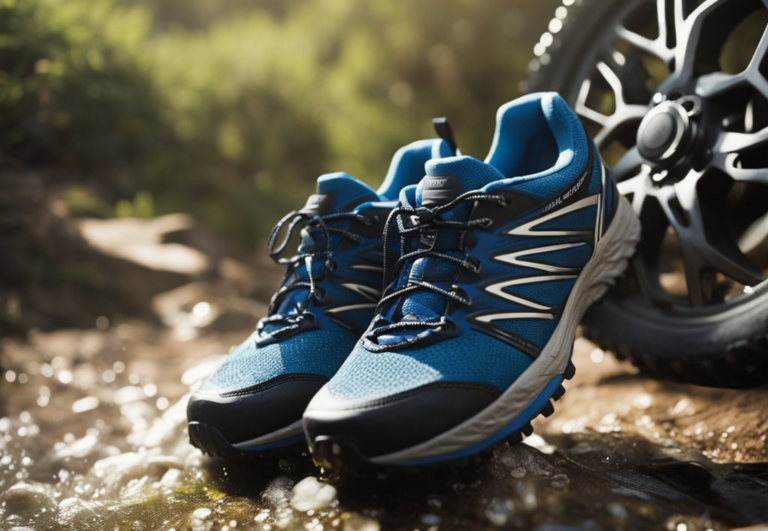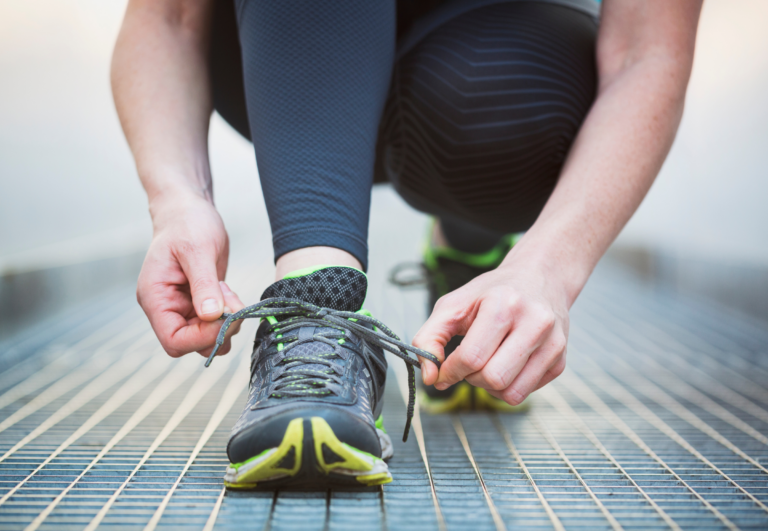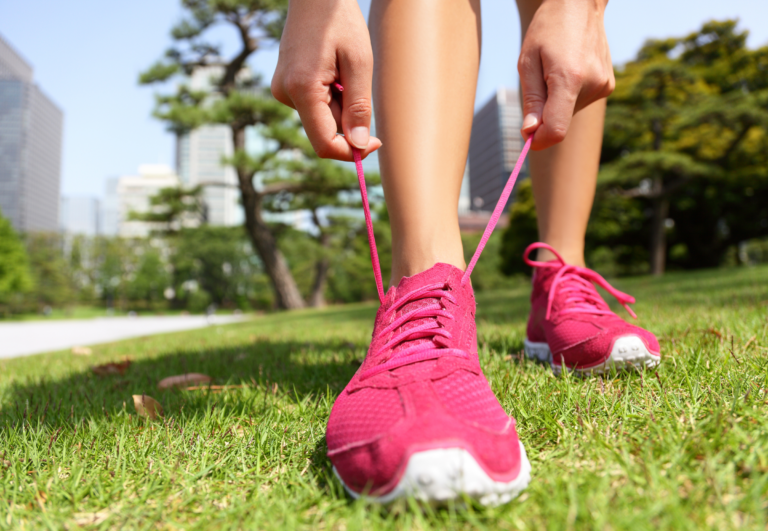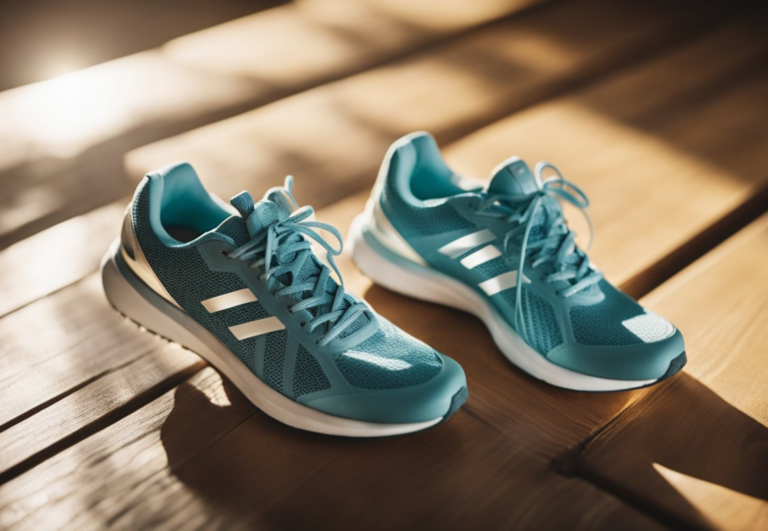Feet Slide Forward in Running Shoes? (4 Common Causes AND Fixes)
When you find your feet sliding forward in running shoes, it’s often due to a combination of reasons such as improper shoe fit, incorrect lacing techniques, or the wrong type of socks.
Ensuring a proper fit is essential; your heels should fit snugly without slipping, and there should be a thumb’s width of space in the toe box. This is the fix you need. Understanding the scope of sizing, from utilizing a tongue-aligned fit to considering soles depth and rigidity, is key. A tip or trick that many seasoned runners mention is the importance of the toebox and the heel lock method for additional stability.
Using the “runner’s loop” or “runner’s lock” lacing method can enhance heel support while selecting moisture-wicking socks can prevent slippage caused by sweat. These are not mere loops and knots, but a strategic planning of the best way to secure your feet, passing the laces through the eyelet the right way. These elements, from heel fit to the choice of soles, can significantly improve your stability and comfort, preventing blisters, toenail damage, and other issues that can arise from your feet moving inside your shoes during a run.
Note that stride anomalies like over-pronation or under-supination could also impact your overall comfort and efficacy of your run.
Why Your Feet Slide Forward in Running Shoes
Experiencing your feet sliding forward in running shoes can compromise your stability and the rhythm of your stride. Understanding the common causes can offer a solution to this issue for a better running experience.
Improper Shoe Fit
The most direct cause for feet sliding forward in running shoes is an incorrect size. Shoes that are too large will allow your feet to move excessively. Conversely, a snug fit is crucial, especially around the toe box, to prevent your toes from pushing against the front of the shoe. Possible tricks like trying out different lacing styles or investing in interchangeable soles could help in achieving the perfect fit.
Proper shoe fit criteria for running shoes don’t just end at sizing and sole structure. The heel lock method or runner’s loop is highly recommended for keeping your heel in place and preventing the feet from sliding forward.
Proper shoe fit criteria for running shoes:
- Heel: Should fit snugly without slipping
- Width: Enough room to move toes without pressure
- Length: About a thumb’s width between your big toe and the shoe end
- Arch support: Matches the contour of your feet, be it high arches or flat feet
Wrong Lacing Technique
A method often overlooked is the lacing of your shoes. The “runner’s loop” can provide extra heel support to prevent sliding. Ensure laces are snug but not overly tight, as this might cause discomfort and affect blood circulation.
The tongue of the running shoe also plays a crucial role in a comfortable fit, so ensure it’s well adjusted with each wear.
Simple Lacing Adjustments for Better Fit offer more than just aesthetic appeal; they are vital for runners to ensure they don’t lose their shoes midway during an intense session.
Simple Lacing Adjustments for Better Fit
- Double-back lacing at the narrow heels to secure position
- Use all eyelets for even distribution of pressure
- Leave no loose ends to maintain consistency in fit
Sock Material or Design
The socks you wear play a significant role in the fit of your running shoes. Materials with good moisture management, such as synthetic blends, can help maintain a consistent fit, whereas cotton might get wet and cause slipping.
Socks Attributes for Optimal Shoe Fit
- Moisture-wicking: Keeps feet dry
- Thickness: Compatible with shoe’s internal volume
- Texture: Provides grip inside the shoe
Sweaty or Wet Feet
Sweat can reduce friction, causing your feet to slide forward, especially if your running shoes and their soles lack proper internal traction. Using foot powders or antiperspirant can mitigate this by absorbing moisture.
Tips to Handle Sweaty Feet come in handy for long distance runners. With the right tricks, you can focus on improving speed and endurance instead of worrying about foot slippage.
Tips to Handle Sweaty Feet
- Foot powders: Absorbs moisture for a drier environment
- Breathable shoes: Promotes air circulation to reduce sweat buildup
By addressing these issues, you can secure a more stable and comfortable fit in your running shoes, enhancing your overall performance and experience.
Preventative Measures to Stop Feet Sliding Forward

To ensure comfort and prevent injuries to your feet and toes, it’s critical to stop your feet from sliding forward in your running shoes. The solution lies in a combination of tactics, from your socks, to your lacing techniques, to maintain a snug and secure fit during your runs.
Selecting the Right Socks and Insoles
Socks:
- Choose moisture-wicking socks to keep feet dry and reduce slippage.
- For added grip, look for socks with texturized areas on the heel.
Insoles:
- Orthotics or shoe inserts can provide extra support and prevent forward sliding.
- Consider custom orthotics for a personalized fit that complements the contours of your feet.
Lacing Techniques for Improved Grip
Experiment with different lacing techniques until you find one that prevents your foot from slipping forward yet feels comfortable.
Heel-lock lacing or lace lock: This technique secures your heel in place and minimizes movement by creating an adjustable loop at the top eyelet, giving your toes ample space in the toebox without compromising heel stability.
| Lacing Technique | Description | Benefit |
|---|---|---|
| Criss-Cross | Standard lacing pattern for snug fit. | Even pressure distribution. |
| Loop-Lock | Creates extra friction near the ankle. | Secures the ankle and locks heel. |
Using Products to Enhance Heel Fit
- Heel grips: Adhesive padding that can be stuck inside the back of your shoe to reduce space and improve grip around the heel area.
- Double-sided tape: Applied to the inside of your shoe under the ball of your foot can offer temporary additional grip.
Remember, a combination of these methods may provide the best result for keeping your feet securely in place while you run.
Common Issues Caused by Your Foot Sliding Forward in Running Shoes

When your foot slides forward in a running shoe, it can lead to a variety of painful problems, including blisters and damage to your toenails. It can also contribute to foot conditions such as plantar fasciitis and metatarsalgia.
Dealing with Blisters and Toenail Damage
Blisters form when there’s friction between your skin and the shoe, often happening when your foot slides to the front. To treat blisters, cleanse the area and cover it with a sterile bandage.
To prevent them, ensure your shoes fit snugly and consider moisture-wicking socks.
Toenail Damage can occur from the continuous pressure of toes hitting the shoe front. Severely damaged nails can become painful or even lead to toenail loss. Keep your toenails trimmed and, if pain persists, consult a healthcare provider.
| Preventative Care for Blisters and Toenail Damage |
|---|
| Choose the right size shoe |
| Use proper lacing techniques to secure the foot |
| Wear appropriate socks to reduce moisture |
| Keep toenails short and clean |
Understanding Plantar Fasciitis and Metatarsalgia
Plantar Fasciitis is characterized by pain at the bottom of your heel. It’s often caused by strain on your plantar fascia, the ligament connecting your heel bone to your toes. Proper footwear that fits well can help alleviate and prevent this strain.
Metatarsalgia presents as pain and inflammation in the ball of your foot and can result from excess pressure due to your foot sliding forward. Cushioned insoles or pads can provide relief, and rest is crucial for recovery. If swelling and pain persist, seek medical attention.
| Treatment and Recovery Tips |
|---|
| Rest and ice to reduce swelling |
| Use insoles for cushioning and support |
| Stretch your feet regularly |
| Consult a healthcare professional if pain lasts |
Improving Running Technique and Injury Prevention

When thinking about how to enhance your running experience, it’s crucial to consider both technique refinement and injury prevention strategies. Not only can these approaches help you run more efficiently, but they can also minimize the risk of injuries that often stem from poor mechanics, such as incorrect pronation or supination.
The Role of a Running Coach in Technique Refinement
Seeking the guidance of a running coach can be a game-changer for your running technique. A coach will assess your running mechanics, identify any imbalances or improper movements, and work with you to correct them.
This can include understanding your stride and how to incorporate effective tricks like heel lock lacing that can stabilize your foot, minimizing excessive pronation or supination.
- Adjusting your posture: to ensure you’re running tall and not slouching.
- Optimizing foot strike: to moderate the impact on your joints and prevent pain.
A running coach can tailor training sessions to your needs, which can lead to a more enjoyable and injury-free running experience.
Custom Conditioning and Recovery Strategies
Incorporating custom conditioning exercises and implementing recovery strategies can greatly reduce your risk of injury.
A podiatrist or coach may suggest exercises that strengthen the muscles used in running, which supports better overall mechanics and can help prevent injury.
Key components include:
- Strength training: targeting leg and core muscles for improved stability.
- Flexibility routines: such as post-run stretching to maintain good muscle health.
Recovery should not be overlooked, as it is crucial for treatment and future injury prevention. This may involve:
- Active recovery: like walking or cycling on rest days.
- Adequate rest: ensuring you get enough sleep for muscle repair.
Consistent use of these strategies will help keep you on track and reduce the likelihood of running-related injuries.






